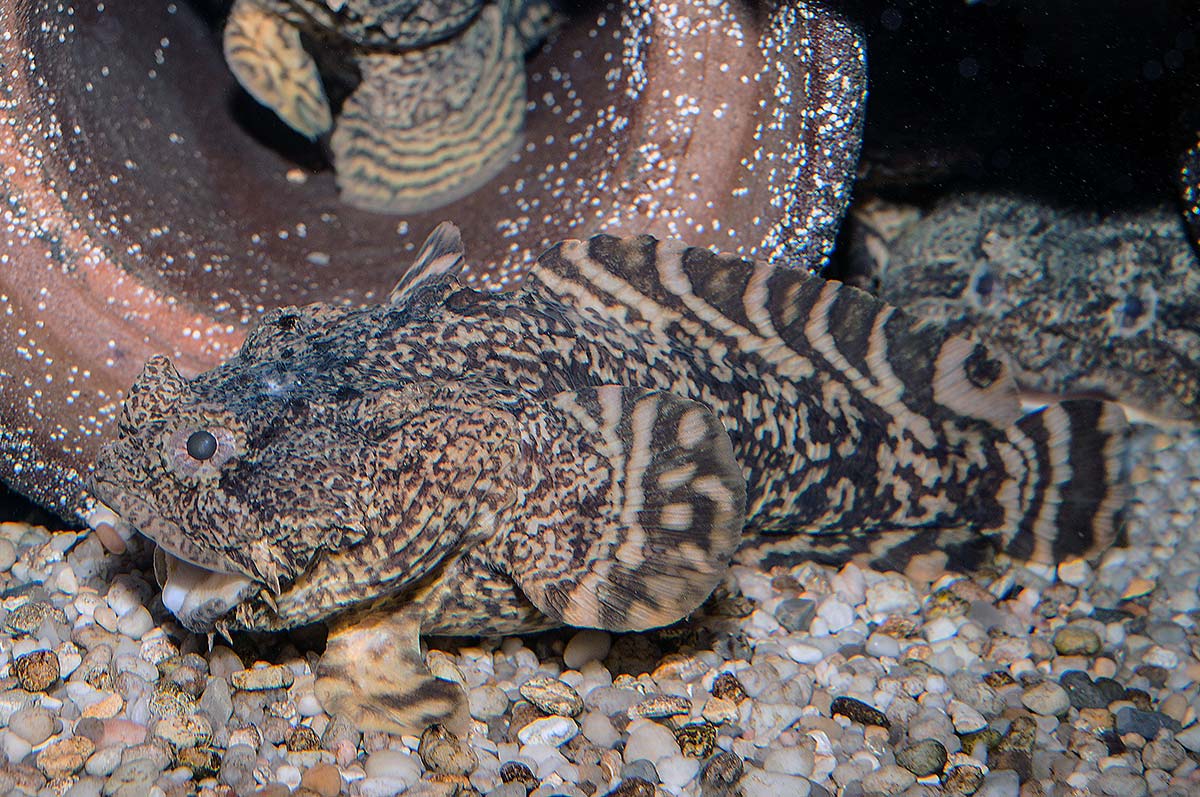
What the heck is that?!?!
The oyster toadfish is one strange looking fish. To me it looks like it has been hit on the top of the head too many times with a hammer! This species has a very large mouth in relationship to the size of their body. The pectoral fins look like small hand fans on either side of its head. It’s just a weird looking fish.
The oyster toadfish have fleshy sea anemone-like appendages growing from around the mouth area, one way in which scuba divers tell them apart from the sea raven, monkfish, some sculpin members, and certain stonefish, or scorpionfish. Those are in addition to leopard and gulf toadfish in terms of other species with a similar appearance. The second feature that helps with a positive ID is the flattened appearance of its head.
This species can be found along the Atlantic Coast from the West Indies to Cape Cod. In North Carolina estuaries you can hear the male toadfish actively vocalizing underwater near piers and other structures during the mating season, making a distinctive “boat-whistle” sound. Oyster toadfish are also known as an oyster cracker, or ugly toad.
Most oyster toadfish encountered by anglers are around 12 inches in length, but they can grow a maximum size of 17 inches long. Their coloration is a yellowish hue with brown bars running through the body. They have the ability to change their color in order to blend into the bottom they are sitting on, and have blue-greenish colored eyes. Oyster toads are able to live and thrive in poor water conditions and get-by with less food than other fish species of similar size.
Their preferred habitat includes rocky, sandy, and muddy bottoms, and can usually be found around structure. I have seen these animals perfectly content hiding in man-made objects like clay pipes, empty cans, plastic containers, and the like. You can also find them living in eelgrass beds, on oyster reefs, and in hollows or dens. The strong teeth and jaws of the oyster toadfish are capable of crushing the hard shells of mollusks and are often used to fight with other oyster toadfish. They snap viciously when caught.
The oyster toadfish has scale-less skin with thick mucus and warts, giving it the appearance of a toad. They have a large head and a tapering body with a plump belly. It has a rounded nose and a very big mouth with blunt teeth. On the gill cover, there are two spines. When they swim, their pectoral fins stretch out like a fan, which is located under its throat.
You do need to be careful when handling this fish, because this species is venomous and you need to take care when near their sharp gill plates, because there is the potential risk of being injected with a moderate poison that can be painful, but not as dangerous as a saltwater catfish, or scorpionfish.
The male will build his nest after sunset in the dark. Once completed, the male starts to make the “boat whistle” sound in order to attract a female during spawning season. These sounds can be heard from quite a distance from his nest and can be heard by people scuba diving, or snorkeling in water.
Spawning usually takes place from July through August. The female will lay her eggs on solid substrate such as rock under submerged wood and sometimes in discarded tin cans, or disposed pipe sections. After fertilization, the male guards his brood of eggs and cleans the nest and uses his fins to fan the eggs until they hatch. The eggs will hatch after approximately one month, depending upon water temperatures. Eggs are approximately 1/5th of an inch in diameter, the largest eggs of any fish in local bays and sounds. The male guardian watches the young fish for three to four weeks until they become big enough to feed by themselves and/or until they become free swimmers.
The tadpole-like youngsters stay attached to the nest by a yolk. Once the yolk is completely absorbed by the growing toadfish, the male continues to guard the young fish for a few more weeks, even though they are free to swim in and out of the nest. Both the male and female become sexually mature by about age 2; the males may live to be 8 years old, while females can live until they are around 5 years. With powerful jaw and teeth capable of crushing its prey, they’ll feed on oysters, small crustaceans, as well as worms, squid, mollusks and other small fish.
Because of its size, low sensitivity to pollution, and ability to live out of the water for extended periods of time, the oyster toadfish serves as an important animal for marine research.



